Walnut cutting boards offer a rich, dark finish with natural antibacterial properties, ideal for preserving knife sharpness and aesthetics. Hickory boards provide superior hardness and durability, making them highly resistant to scratches and heavy use in busy kitchens.
Table of Comparison
| Feature | Walnut | Hickory |
|---|---|---|
| Hardness (Janka) | 1010 | 1820 |
| Durability | Moderate | High |
| Grain Pattern | Fine, straight to wavy | Coarse, pronounced |
| Color | Rich chocolate brown | Light to medium brown with reddish hues |
| Maintenance | Regular oiling recommended | Frequent oiling advised |
| Price | Moderate | Affordable |
| Best Use | Elegant, gentle use cutting boards | Heavy-duty, high-impact cutting boards |
Introduction to Walnut and Hickory Cutting Boards
Walnut cutting boards are prized for their rich, dark brown hues and tight grain, offering durability and a naturally smooth surface that resists knife marks. Hickory cutting boards feature a lighter color with a distinct grain pattern, known for exceptional hardness and resilience, making them ideal for heavy-duty kitchen use. Both hardwoods provide strong resistance to moisture and bacteria, ensuring longevity and safe food preparation environments.
Wood Hardness and Durability Comparison
Walnut cutting boards have a Janka hardness rating of approximately 1,010, making them moderately hard and resistant to knife marks while offering a smooth surface ideal for chopping. Hickory, with a Janka hardness around 1,820, is significantly harder and more durable, providing superior resistance to dents and scratches but potentially dulling knives faster. The increased density of hickory ensures longevity under heavy use, whereas walnut balances durability with a gentler impact on knife edges for frequent culinary tasks.
Grain Patterns and Aesthetic Appeal
Walnut cutting boards feature rich, dark brown hues with subtle grain patterns that provide a sleek, modern aesthetic favored by contemporary kitchens. Hickory cutting boards boast pronounced, varied grain with contrasting light and dark streaks, offering a rustic and bold visual appeal ideal for farmhouse or traditional settings. The choice between walnut and hickory hinges on preference for either smooth, uniform elegance or striking, textured character.
Knife Friendliness and Surface Impact
Walnut cutting boards offer superior knife friendliness due to their moderate hardness, which helps maintain blade sharpness and reduces dulling over time. Hickory boards are significantly harder, causing quicker blade wear and potential damage to cutlery edges. The softer walnut surface also minimizes knife marks, preserving board aesthetics and extending its usability compared to the more abrasive surface of hickory.
Maintenance and Ease of Cleaning
Walnut cutting boards require regular oiling with food-safe mineral oil to maintain their rich color and prevent drying, while hickory boards need similar conditioning but may demand more frequent attention due to their open grain structure. Both woods resist water absorption fairly well, but walnut's tighter grain makes it less prone to staining and easier to clean with mild soap and warm water. Avoid soaking or dishwasher use for both, as prolonged moisture exposure can cause warping and cracking, impacting their longevity and maintaining hygiene.
Resistance to Stains and Odors
Walnut cutting boards exhibit moderate resistance to stains and odors due to their tight grain and natural oils, making them less prone to discoloration and absorbing smells. Hickory boards, with their denser and more porous structure, tend to absorb stains and odors more readily, requiring more frequent maintenance and conditioning. Choosing walnut offers a balance of durability and easier upkeep when resisting everyday kitchen stains and odors.
Cost and Availability
Walnut cutting boards typically cost more due to their rich, dark color and fine grain, which makes them highly sought after in premium kitchenware markets. Hickory boards offer a more budget-friendly option with comparable durability, benefiting from greater availability in regions where hickory trees are abundant. Both woods provide strong, long-lasting surfaces, but walnut's limited supply and higher price point may impact purchasing decisions more than hickory's widespread availability and affordability.
Sustainability and Sourcing
Walnut cutting boards are often sourced from sustainably managed forests, offering a balance between durability and environmental responsibility due to their slower growth rate and lower impact harvesting practices. Hickory boards, while exceptionally hard and durable, can sometimes come from less regulated sources, raising concerns about deforestation and habitat disruption. Choosing walnut from certified suppliers ensures eco-friendly harvesting, whereas verifying the origin of hickory is essential to support sustainable forestry practices.
Best Uses for Walnut vs. Hickory Boards
Walnut cutting boards excel in precision tasks such as slicing fruits, vegetables, and boneless meats due to their fine grain and smooth surface, providing gentle care for sharp knives. Hickory cutting boards, known for their exceptional hardness and durability, are ideal for heavy-duty chopping, including bones and dense foods, making them perfect for butchers and serious home chefs. Both woods resist moisture well, but walnut's natural oils offer additional antimicrobial properties, while hickory's toughness withstands prolonged heavy use without significant wear.
Final Verdict: Which Is Better for Your Kitchen?
Walnut cutting boards offer a rich, dark finish with natural resistance to moisture and bacteria, making them ideal for durability and aesthetics in the kitchen. Hickory provides exceptional hardness and toughness, resisting deep cuts and scratches, perfect for heavy-duty use and longevity. Choosing between walnut and hickory depends on whether you prioritize a combination of beauty and moderate durability or require maximum hardness and wear resistance for frequent, intense chopping tasks.

Infographic: Walnut vs Hickory for Cutting Board
 azmater.com
azmater.com